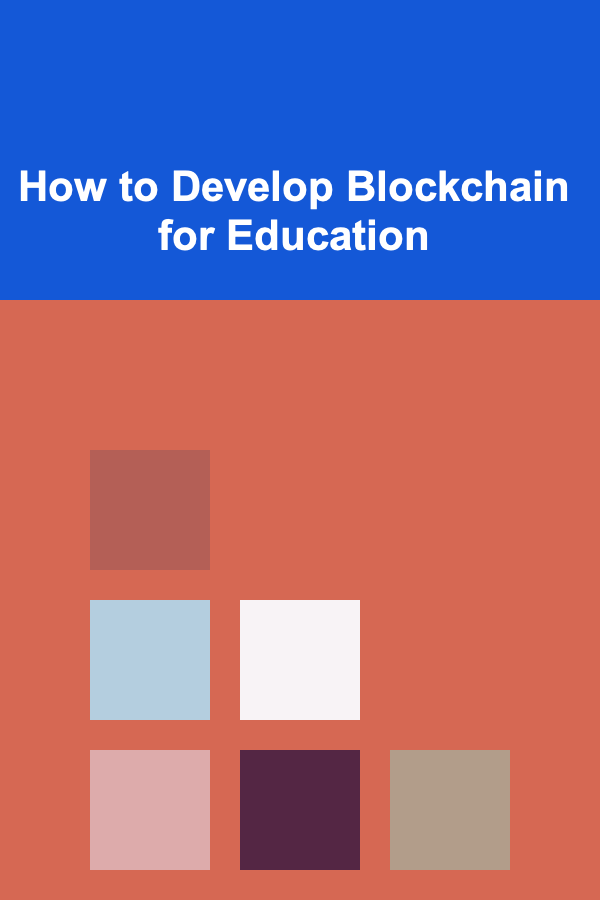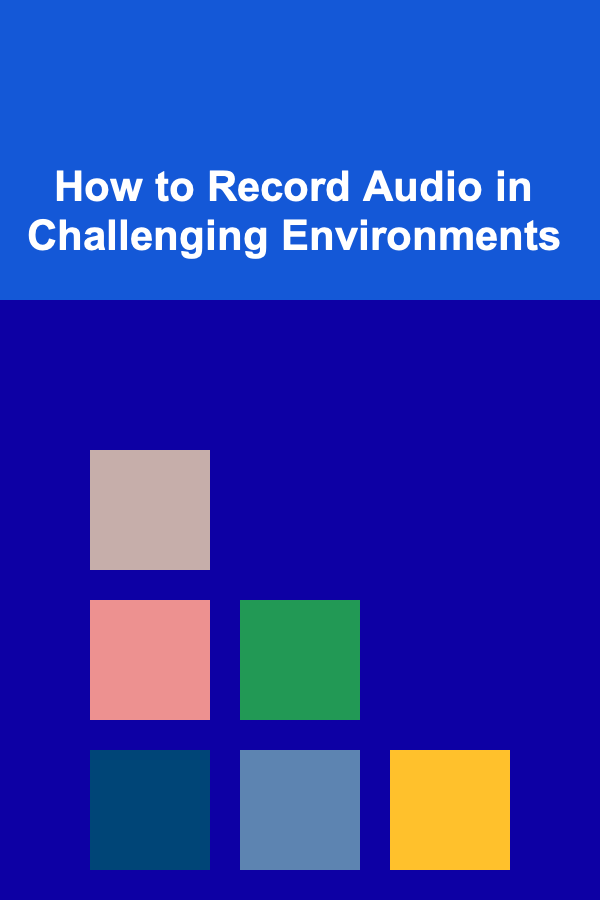
How to Develop Blockchain for Education
ebook include PDF & Audio bundle (Micro Guide)
$12.99$8.99
Limited Time Offer! Order within the next:

In recent years, blockchain technology has emerged as a revolutionary force, with its application spanning from finance to healthcare, and even the education sector. The decentralized nature of blockchain makes it an ideal candidate for solving a variety of challenges faced by educational institutions, students, and educators. In this article, we will explore how blockchain can be developed and implemented in education, the benefits it brings, and the challenges that need to be addressed for widespread adoption.
Introduction to Blockchain in Education
Blockchain is often referred to as a distributed ledger technology (DLT) that enables secure, transparent, and immutable transactions without the need for intermediaries. The concept originated with the creation of Bitcoin in 2009 by an anonymous person or group known as Satoshi Nakamoto. Since then, blockchain has evolved into a multifaceted technology that offers numerous potential applications beyond cryptocurrencies.
For the education sector, blockchain has the ability to address several longstanding issues, including credential verification, intellectual property rights management, and ensuring the security of student data. By utilizing blockchain, educational institutions can create decentralized platforms that allow students, educators, and administrators to interact in ways that are more efficient, transparent, and secure.
Benefits of Blockchain in Education
Before diving into how to develop blockchain for education, it is important to first understand the key benefits that blockchain can offer to the educational sector:
1. Credential Verification and Academic Records
One of the biggest challenges in education is the verification of academic credentials. This process often involves lengthy checks between educational institutions, employers, and other parties. Blockchain can provide a secure and efficient way to store and verify academic records. By storing credentials on a blockchain, they become immutable, tamper-proof, and easily accessible to authorized parties.
For example, universities could issue digital diplomas and certifications to students on the blockchain. These records would be timestamped and stored in a way that makes them nearly impossible to forge or alter. Employers or other institutions could easily verify the authenticity of these credentials without the need for third-party verification services.
2. Intellectual Property Protection for Educational Content
In the age of open-source educational resources and digital content, it is critical to ensure that intellectual property rights are protected. Blockchain technology can help content creators, such as educators and institutions, track and manage the usage of their educational materials.
By registering educational content, such as textbooks, lecture notes, and video lectures, on the blockchain, creators can maintain ownership and control over how their materials are used. This not only ensures fair compensation but also prevents unauthorized distribution of content. Additionally, blockchain allows for easy tracking of content usage, giving educators insights into how their materials are being utilized.
3. Student Data Security and Privacy
With the increasing use of digital platforms for learning, the security and privacy of student data have become significant concerns. Blockchain offers a way to store sensitive information securely, ensuring that only authorized users can access it.
By implementing blockchain in education, students can have more control over their personal data, including grades, attendance, and even their learning preferences. With smart contracts, students can grant or revoke access to their information on an as-needed basis, ensuring that their data is protected from unauthorized access.
4. Decentralized Learning Platforms
Blockchain technology can enable the creation of decentralized learning platforms, where students, instructors, and educational institutions can interact in a peer-to-peer manner. This can disrupt traditional educational models by reducing reliance on centralized systems.
Decentralized education platforms can facilitate peer-to-peer learning, provide a marketplace for educational resources, and eliminate intermediaries. This approach can lower costs, increase accessibility, and provide a more personalized learning experience for students.
5. Smart Contracts for Educational Transactions
Smart contracts, which are self-executing contracts with the terms of the agreement directly written into code, can be applied in educational settings to automate a variety of processes. These processes include the registration of students for courses, the payment of tuition fees, and the awarding of certificates or diplomas upon completion of certain requirements.
For instance, when a student completes a course, a smart contract can automatically issue a certificate and update the student's academic record on the blockchain. This reduces administrative overhead and ensures that processes are carried out transparently and efficiently.
Steps to Develop Blockchain for Education
Now that we have an understanding of the benefits, let's dive into the steps involved in developing a blockchain solution for education. These steps encompass a broad approach, from defining the use cases to building the technology and ensuring proper integration within existing systems.
1. Define the Use Cases
Before embarking on the development of a blockchain solution, it is important to clearly define the problem or use case that the blockchain will address. In the context of education, common use cases include:
- Credential Verification: Allow students to have their degrees, certificates, and qualifications verified securely.
- Decentralized Learning Platforms: Create a marketplace for educational content where educators can sell their courses, and students can purchase or access them directly.
- Student Data Privacy: Ensure that student data is securely stored and can only be accessed by authorized parties.
- Smart Contracts: Automate various administrative tasks, such as course registration and tuition fee payment.
By defining the specific use case, educational institutions can align their development efforts with the needs of students, educators, and administrators.
2. Select the Blockchain Platform
Once the use cases are defined, the next step is to select the appropriate blockchain platform. There are several types of blockchains that can be used for educational purposes, including:
- Public Blockchains: These are open and decentralized networks where anyone can join and participate. Examples include Bitcoin and Ethereum. Public blockchains are ideal for applications where transparency and immutability are essential, such as credential verification.
- Private Blockchains: These are permissioned networks where access is controlled. Private blockchains are ideal for institutions that want to retain some level of control over who can participate in the network. For example, a university might use a private blockchain for managing student records.
- Consortium Blockchains: These are hybrid blockchains where a group of institutions or organizations control the network. A consortium blockchain could be ideal for collaboration between multiple universities or educational entities to create a shared system for credential verification.
Each blockchain platform has its pros and cons, and the choice will depend on the specific needs of the educational institution and its stakeholders.
3. Design the Blockchain Architecture
The next step in developing blockchain for education is designing the architecture of the system. This includes:
- Data Structure: Decide how the educational data will be stored on the blockchain. For example, educational records could be stored as transactions, with each transaction representing a certificate, course completion, or other academic achievements.
- Consensus Mechanism: Choose a consensus mechanism that aligns with the goals of the project. Proof of Work (PoW), Proof of Stake (PoS), and Practical Byzantine Fault Tolerance (PBFT) are common consensus algorithms used in blockchain networks.
- Smart Contracts: Design and develop the smart contracts that will automate processes within the blockchain. These contracts can handle tasks such as issuing certificates, verifying credentials, or executing payments.
- Interoperability: Ensure that the blockchain platform can interact with existing educational systems, such as student management systems or learning management platforms.
4. Develop and Deploy the Blockchain
After the architecture has been designed, the next step is to start developing the blockchain solution. This involves writing the code for the smart contracts, setting up the nodes for the blockchain network, and implementing the necessary security features. Additionally, the blockchain solution should be thoroughly tested to ensure it meets the desired use cases.
Once the development phase is complete, the blockchain solution can be deployed and integrated with existing educational systems. This may require some adjustments to ensure that the blockchain can work seamlessly with legacy systems used by educational institutions.
5. Ensure Scalability and Adoption
For blockchain to be effective in education, it needs to be scalable. Educational institutions must ensure that their blockchain solutions can handle a large number of transactions, especially as the number of users grows. Additionally, the adoption of blockchain by students, educators, and institutions is crucial. This can be achieved through awareness campaigns, user training, and providing clear incentives for adoption.
Blockchain technology has the potential to transform education, making it more transparent, secure, and efficient. By developing a blockchain-based system for education, institutions can improve the verification of credentials, protect intellectual property, enhance student data privacy, and automate various processes. While the development of blockchain solutions for education presents several challenges, the long-term benefits are clear, making it an exciting area for innovation.
Conclusion
The future of education lies in the seamless integration of cutting-edge technologies like blockchain. While challenges such as regulatory hurdles and technical complexity remain, the potential of blockchain to improve educational systems and outcomes cannot be ignored. As more institutions begin to explore the use of blockchain, it is likely that we will see a shift toward more transparent, decentralized, and secure systems that benefit all stakeholders in the education ecosystem.

How to Build a Profitable YouTube Channel About Travel
Read More
How to Create an Emergency Escape Plan for Your Family
Read More
How to Use LinkedIn Insights to Tailor Your B2B Dropshipping Marketing Strategy
Read More
How to Record Audio in Challenging Environments
Read More
How to Secure Government Grants for Renewable Energy Projects
Read More
10 Tips for Utilizing Social Media as a Booking Agent
Read MoreOther Products

How to Build a Profitable YouTube Channel About Travel
Read More
How to Create an Emergency Escape Plan for Your Family
Read More
How to Use LinkedIn Insights to Tailor Your B2B Dropshipping Marketing Strategy
Read More
How to Record Audio in Challenging Environments
Read More
How to Secure Government Grants for Renewable Energy Projects
Read More